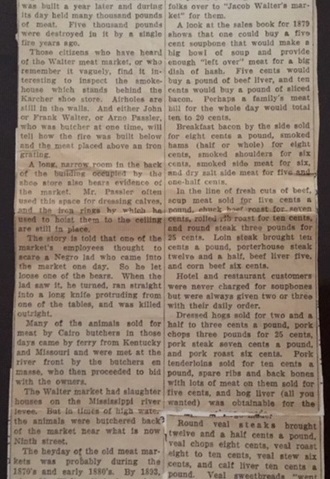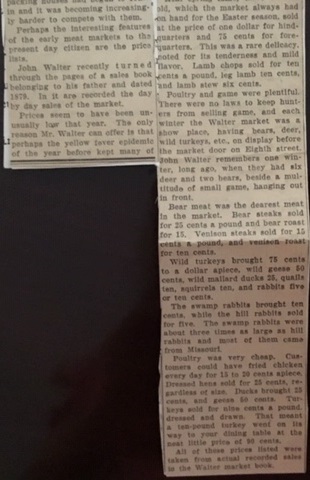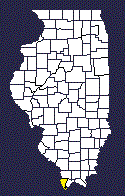


By Anne West
Probably but few Cairoites realize that not more than 250 or 300 feet away from
Cairo's main business center stands an old brick smokehouse, a remnant of the
days when bears and deer hung in front of a teeming meat market on Eighth
street.
The market, which stood at 210 Eighth street, a site now occupied
by the Karcher shoe store, belonged to Jacob Walter, father of John and Frank
Walter and Mrs. D. F. McCarthy.
Mr. Walter was born in Germany and
arrived in New York by way of a whaling ship on which he had sailed as a
whalter. He worked as a doctor's assistant in New York until the outbreak of the
Civil War, when he joined the ranks of fighting men, seeing action, among other
engagements, at the Battle of Belmont.
Around 1866 he came to Cairo, and
in 1868 opened the market on Eighth street. The smokehouse was built a year
later and during its day held many thousand pounds of meat. Five thousand pounds
were destroyed in it by a single fire years ago.
Those citizens who have
heard of the Walter meat market, or who remember it vaguely, find it interesting
to inspect the smokehouse which stands behind the Karcher shoe store. Airholes
are still in the walls. And either John or Frank Walter, or Arno Passler, who
was butcher at one time, will tell how the fire was built below and the meat
placed above an iron grating.
A long, narrow room in the back of the
building occupied by the shoe store also bears evidence of the market. Mr.
Passler often used this space for dressing calves, and the iron rings by which
he used to hoist them to the ceiling are still in place.
The story is
told that one of the market's employees thought to scare a Negro lad who came
into the market one day. So he let loose one of the bears. When the lad saw it,
he turned, ran straight into a long knife protruding from one of the tables, and
was killed outright.
Many of the animals sold for meat by Cairo butchers
in those days came by ferry from Kentucky and Missouri and were met at the river
front by the butchers en masse, who then proceeded to bid with the owners.
The Walter market had slaughter houses on the Mississippi river levee. But
in times of high water the animals were butchered back of the market near what
is now Ninth street.
The heyday of the old meat markets was probably
during the 1870's and early 1880's. By 1893, when Mr. Walter died, the modern packing houses
had begun to come
in and it was becoming increasingly harder to compete with them.
Perhaps
the interesting features of the early meat markets to the present day citizens
are the price lists.
John Walter recently turned through the pages of a
sales book belonging to his father and dated 1879. In it are recorded the day by
day sales of the market.
Prices seem to have been unusually low that
year. The only reason Mr. Walter can offer is that perhaps the yellow fever
epidemic of the year before kept many of the farmers out of town and thus left a
large number of animals to be brought to Cairo for sale in '79. Then, too, with
land as virgin as it was then, the expense of raising stock was slight. The
animals were turned loose in the spring and allowed to wander until roundup time
in the fall.
It was possible to buy first rate cattle for one and a half
cents a pound, and average cattle for a cent less than that.
The Walter
market sold much of its meat to the steamboats which pulled up to the river
front. And in those days as many as fifteen boats a day wasn't uncommon.
Cash registers were unheard of, and John Walter remembers how the money from
sales was just dumped into a drawer and left until it got "heavy" enough to
carry to the bank. There was a special drawer for "spending money" (nickels and
dimes) and when the bank ran short of those two pieces of change it would send
folks over to "Jacob Walter's market" for them.
A look at the sales book
for 1879 shows that one could buy a five cent soupbone that would make a big
bowl of soup and provide enough "left over" meat for a big dish of hash. Five
cents would buy a pound of beef liver, and ten cents would buy a pound of sliced
bacon. Perhaps a family's meat bill for the whole day would total ten to 20
cents.
Breakfast bacon by the side sold for eight cents a pound, smoked
hams (half or whole) for eight cents, smoked shoulders for six cents, smoked
side meat for six, and dry salt side meat for five and one-half cents.
In
the line of fresh cuts of beef, soup meat sold for five cents a pound, chuck
beef roast for seven cents, rolled rib roast for ten cents, and round steak
three pounds for 25 cents. Loin steak brought ten cents a pound, porterhouse
steak twelve and a half, beef liver five, and corn beef six cents.
Hotel
and restaurant customers were never charged for soupbones but were always given
two or three with their daily order.
Dressed hogs sold for two and a half
to three cents a pound, pork chops three pounds for 25 cents, pork steak seven
cents a pound, and pork roast six cents. Pork tenderloins sold for ten cents a
pound, spare ribs and back bones with lots of meat on them sold for five cents,
and hog liver (all you wanted) was obtainable for the asking. No charge made.
Round veal steaks brought twelve and a half cents a pound, veal chops eight cents, veal roast eight to ten cents, veal stew six cents, and calf liver ten cents a pound. Veal sweetbreads "went begging" for 15 cents a pound.
Real spring lamb, three months old, which the market
always had on hand for the Easter season, sold at the price of one dollar for
hindquarters and 75 cents for forequarters. This was a rare delicacy noted for
its tenderness and mild flavor. Lamb chops sold for ten cents a pound, leg lamb
ten cents, and lamb stew six cents.
Poultry and game were plentiful.
There were no laws to keep hunters from selling game, and each winter the Walter
market was a show place, having bears, deer, wild turkeys, etc., on display
before the market door on Eighth street. John Walter remembers one winter, long
ago, when they had six deer and two bears, beside a multitude of small game,
hanging out in front.
Bear meat was the dearest meat in the market. Bear
steaks sold for 25 cents a pound and bear roast for 15. Venison steaks sold for
15 cents a pound, and vension roast for ten cents.
Wild turkeys brought
75 cents to a dollar apiece, wild geese 50 cents, wild mallard ducks 25, quails
ten, squirrels ten, and rabbits five or ten cents.
The swamp rabbits
brought ten cents, while the hill rabbits sold for five. The swamp rabbits were
about three times as large as hill rabbits and most of them came from Missouri.
Poultry was very cheap. Customers could have fried chicken every day for 15
to 20 cents apiece. Dressed hens sold for 25 cents, regardless of size. Ducks
brought 25 cents, and geese 50 cents. Turkeys sold for nine cents a pound,
dressed and drawn. That meant a ten-pound turkey went on its way to your dining
table at the neat little price of 90 cents.
All of these prices listed
were taken from actual recorded sales in the Walter market book.
Contributed Aug 2019, by Deborah McGee Cox, as a part of the McGee Collection.
| Cape Girardeau MO |
Union | |
 |
Pulaski | |
| Scott MO | Mississippi MO | Ballard KY |


